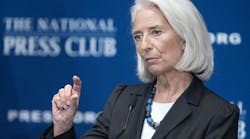“Optimism is in the air: the deep freeze is behind, and the horizon is brighter,” she noted during a nearly hour-long speech at the National Press Club in Washington, D.C. “My great hope is that 2014 will prove momentous in another way—the year in which the ‘seven weak years,’ economically speaking, slide into ‘seven strong years.’ Is this wishful thinking? No, but it will not simply happen on its own. Getting beyond the crisis still requires a sustained and substantial policy effort, coordination, and the right policy mix.”
Lagarde pointed out that global economic “momentum” strengthened in the latter half of 2013, and should strengthen further in 2014—largely due to improvements in the “advanced economies” of the world, such the U.S., Europe, Japan, etc.
“Yet global growth is still stuck in low gear,” she stressed. “It remains below its potential, which we think is somewhere around 4%. This means that the world could create more jobs before we would need to worry about the global inflation genie coming out of its bottle.”
Even for the advanced economies, Lagarde warned, the IMF’s outlook is still subject to what she dubbed “significant risks” as well.
“With inflation running below many central banks’ targets, we see rising risks of deflation, which could prove disastrous for the recovery,” Lagarde explained. “If inflation is the genie, then deflation is the ogre that must be fought decisively.”
[Olivier Jean Blanchard, the IMF’s chief economist, fleshed out the group’s forecast a little further in the video clip below.]
Lagarde went on to note that during the “years of crisis” that are commonly referred to as the Great Recession, the global economy relied on emerging markets to keep everything afloat.
“Together with the developing countries, they accounted for three-quarters of global growth over the past half-decade,” she pointed out. “However, a growing number of emerging markets are slowing down as the economic cycle turns. We also see risks arising from financial market turbulence and the volatility of capital flows.”
So, overall, while Lagarde believes the direction is “positive” for the global economy, growth is still too low, too fragile, and too uneven.
“Moreover, it is not enough to create the jobs for the more than 200 million people around the world who need them,” she said. “In far too many countries, the benefits of growth are being enjoyed by far too few people. Just to give one example: in the U.S., 95% of income gains since 2009 went to the top 1%. This is not a recipe for stability and sustainability.”
Lagarde thinks the big priority for policymakers in 2014 should be to “fortify,” in her words, the “feeble global recovery” and make it sustainable.“For the advanced economies in particular, it means that central banks should return to more conventional monetary policies only when robust growth is firmly rooted,” she pointed out. “At the same time, countries need to use the room created by unconventional monetary policies to put in place the reforms needed to jumpstart growth and jobs.”
Closer to home, the Federal Reserve Bank of Philadelphia noted late last week that its indicators suggest continued moderate growth is ahead for its region – which may also indicate positive trend lines for the U.S. as a whole, too.
“Manufacturing growth in the region continued in January, according to firms responding to this month’s Business Outlook Survey, [with] the survey’s broadest indicators for general activity, new orders, shipments, and employment [in] positive [territory] signifying continued moderate growth,” the Philly Fed noted. “The survey's indicators of future activity moderated but continue to suggest general optimism about growth over the next six months.”
Here’s a breakdown of the Philly Fed’s January survey findings:
- The diffusion index of current manufacturing activity increased from a revised reading of 6.4 in December to 9.4 in January, with the index now in positive for eight consecutive months
- The current shipments and new orders indexes remained positive but moved in opposite directions compared with December. The demand for manufactured goods, as measured by the current new orders index, decreased from a revised reading of 12.9 in December last year to 5.1 in January, though shipments continued to expand with its index edging slightly higher to a reading of 12.1
- Labor market indicators showed some improvement in January with the current employment index increased 6 points from its revised reading in December, though some firms reported reduced work hours
- Cost pressures were slightly more widespread this month among reporting firms, with the “prices paid” index increasing 2 points to 18.7. But with respect to firms’ own manufactured goods, price increases were less widespread this month as the “prices received” index decreased 6 points to 5.1.
- The survey’s future indicators have recently shown moderating optimism about growth in manufacturing, with the future general activity index falling 10 points, from a revised reading of 44.8 in December to 34.4 in January. Still, nearly 48% of the firms participating in the Philly Fed’s survey expect increases in activity over the next six months with only 13 percent of those firms indicating that they expect decreases.
- The indexes for future new orders and shipments also remained at relatively high levels though they dropped by 7 points and 9 points, respectively. Yet the future employment index was virtually unchanged at 17.5, with nearly 25% of the firms expecting to increase employment over the next six months.
Overall, the Philadelphia Federal Reserve feels its January survey data suggests that manufacturing firms in its region by and large expect growth over the first half of 2014 – and that is the kind of growth that generates freight for truckers to haul. Will it materialize for the nation as a whole, though? That of course will remain unknown until it actually happens.





